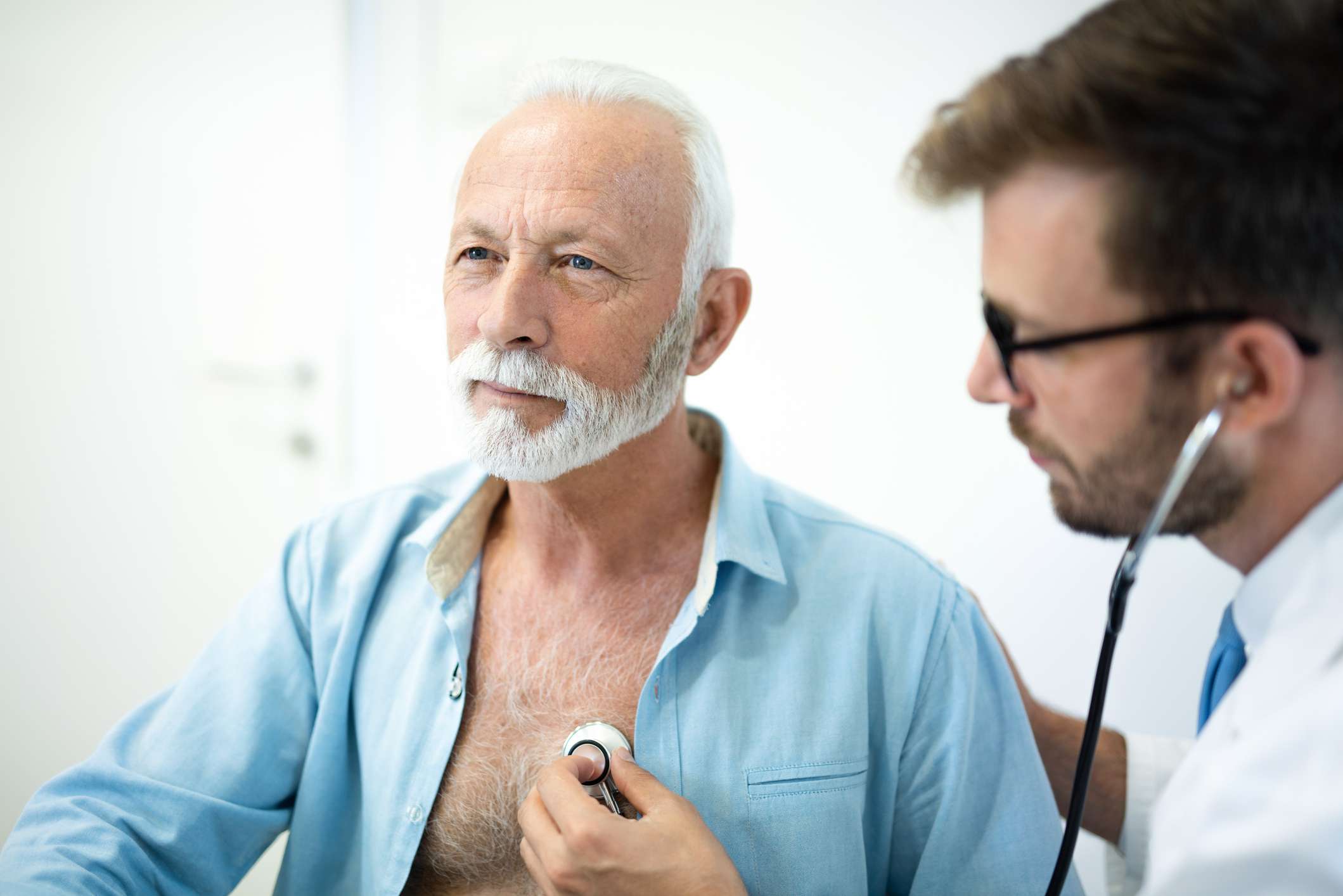Patient education: Lung cancer risks, symptoms, and diagnosis
Lung cancer is a serious disease that affects many people and their families. Lung cancer is the leading cause of cancer death in the United States.
 Cigarette smoke causes most lung cancers, but there are many other that also affect a person's chance of developing lung cancer.
Cigarette smoke causes most lung cancers, but there are many other that also affect a person's chance of developing lung cancer.
When a person has lung cancer, tests can determine the type of lung cancer and whether it has spread. When cancer is suspected, X-rays, imaging scans, as well as blood tests are done. A biopsy is a procedure done to remove a small piece of tissue from a tumor so it can be tested and examined under a microscope.
When a cancer spreads, this is called "metastasis." Cancer stage is determined by the size of the tumor and whether or not it has spread to lymph nodes or other parts of the body. The stage increases as the tumor gets larger or has metastasized (spread). Stage is one of the features that are used to guide treatment choices.
This article will discuss the risks for developing lung cancer, the different types of lung cancer, the signs and symptoms, and testing for people who have lung cancer. Finally, this article will review steps that are taken to determine the stage.
The treatment of lung cancer is discussed separately. (See "Patient education: Non-small cell lung cancer treatment; stage I to III cancer (Beyond the Basics)" and "Patient education: Non-small cell lung cancer treatment; stage IV cancer (Beyond the Basics)" and "Patient education: Small cell lung cancer treatment (Beyond the Basics)".)
More detailed information about lung cancer is available by subscription. (See 'Professional level information' below.)
CANCER CARE DURING THE COVID-19 PANDEMICCOVID-19 stands for "coronavirus disease 2019." It is an infection caused by a virus called SARS-CoV-2. The virus first appeared in late 2019 and has since spread throughout the world. Especially at the beginning of the pandemic, and while the virus was spreading quickly in a lot of places, people in many areas were told to stay home as much as possible in order to slow the spread of the virus. This has been particularly important for people with cancer, as many of them are at increased risk of severe illness if they get COVID-19. However, this risk must be balanced against the importance of continuing to get regular medical care to monitor and treat their cancer, especially now that the pandemic is being brought under control in many but not all parts of the world.
If you live in an area where there are still a lot of cases of COVID-19 and are undergoing treatment for cancer, your oncologist can talk to you about whether you should make any changes to your usual regimen or schedule. In some cases, it may be an option to reduce the number of appointments you need to attend in person. This will depend on several different things, including where you live, how much the virus is still spreading in your community, the type and stage of your cancer, available treatment options, and your overall health.
KNOWN RISK FACTORS FOR LUNG CANCERThe likelihood of a person getting lung cancer is affected by many things; these are called "risk factors." Common risk factors for lung cancer include exposure to tobacco smoke; exposure to radiation or other toxic materials; having close family members who have had cancer; age; and health history, including presence of lung disease. Although many people who get lung cancer have more than one of these risk factors, there are some people for whom the cause of cancer is unknown.
Tobacco smoke — Cigarette smoking is the most common cause of lung cancer. Cigar and pipe tobacco smoking also cause lung cancer. Tobacco smoking is estimated to cause 80 to 85 percent of all lung cancers in the United States. A smoker's risk of developing lung cancer is 10 to 30 times greater than that of a nonsmoker. All forms of tobacco use, including pipes, cigars, and chewing tobacco, can cause cancers of the mouth, throat, and lungs.
The risk of lung cancer increases with the number of cigarettes smoked per day and the number of years of smoking. A person's lifetime exposure is measured in "pack-years," or by the number of packs of cigarettes smoked per day multiplied by the number of years smoked. For example, a person who smoked one pack per day for 20 years would be said to have 20 pack-years of smoking exposure.
Quitting smoking can reduce the risk for lung cancer regardless of how many years a person has smoked. The risk of cancer goes down after quitting. Stopping smoking is very difficult, but the chance of success can be improved with counseling, nicotine-replacement products, and medications. (See "Patient education: Quitting smoking (Beyond the Basics)".)
Secondhand smoke — Secondhand smoke, sometimes called passive smoking, can be dangerous for both adults and children. Secondhand smoke contains the same toxic substances as directly inhaled smoke. Secondhand smoke is an important cause of death from both lung cancer and heart disease. It is also a risk factor for other lung problems such as bronchitis, sinus problems, and ear infections in both adults and children.
Radiation — Radiation from any source can damage tissues and increase a person's risk of cancer over time or at high doses. Radiation sources can be found in the home, in the environment, from occupation or military uses, and in health care (from X-rays and radiation therapy to treat disease).
Radon — Radon in homes and workplaces is recognized as an important risk factor for lung cancer. Radon is a radioactive gas that occurs naturally in the ground. Radon leaks out of the ground and into houses or buildings, where it is then inhaled. You cannot see or smell radon. This is why a special test of the air in the building is used to measure if radon is present. For more information about radon and testing recommendations, there are resources on the internet such as the United States Environmental Protection Agency (http://www.epa.gov/radon/), as well as many other state-based guides. Buildings that have elevated radon levels should have radon mitigation to vent the radon outside or to seal the building against radon entry.
Occupational and environmental factors — Substances at work or in the environment can increase a person's risk of developing lung cancer. Frequent indoor use of "biomass" fuel such as wood or coal for cooking is a risk factor for lung cancer, particularly for women. Industrial factors include work with asbestos, arsenic, radiation, and some chemicals. Dusts and fumes from metals such as nickel, chromium, and others may also increase the risk of lung cancer.
Age — The risk of developing lung cancer increases with age. Lung cancer can occur in young people, although it is unusual in people younger than 40 years old. After age 40, the risk for developing lung cancer slowly increases each year.
Family and genetic risk — Some people have a genetic predisposition to lung cancer. Anyone with a first-degree relative (parent or sibling) with lung cancer has a higher risk of developing lung cancer themselves.
Lung disease and other cancers — People who have had another type of cancer may also be at risk for developing lung cancer. This is particularly true for people who have had cancer related to tobacco use, such as throat cancer, or those who have had radiation treatment in the area of their chest. In addition, people who have chronic obstructive pulmonary disease (COPD) or pulmonary fibrosis have an increased risk for developing lung cancer.
SCREENING FOR LUNG CANCERThe most important steps to reduce the chance of getting lung cancer are to quit smoking, to check for radon in the home and address it if needed, and to use required protection in workplaces that have hazardous substances. Lung cancer screening is not recommended for people considered to be at low risk.
For people at high risk, lung cancer screening with low-dose computed tomography (CT) scans can reduce the risk of death from lung cancer. This applies to people who are between the ages of 50 and 80, have a history of 20 pack-years of cigarette use (for example, 1 pack a day for 20 years, or 2 packs a day for 10 years) or more, and continue to smoke or have quit within the past 15 years. More detailed information about lung cancer screening is available separately. (See "Patient education: Lung cancer prevention and screening (Beyond the Basics)".)
LUNG CANCER SYMPTOMSWhen lung cancers are small and early stage, the person may feel normal and have no symptoms. If the cancer grows into advanced stages, most people develop one or more symptoms. However, the symptoms of lung cancer may be the same as symptoms of other more common problems. If you are concerned about your symptoms, talk to your doctor or nurse.
The most common symptoms of lung cancer include:
?Cough – A cough that is new, getting worse, or will not go away can be a symptom of lung cancer. (See "Patient education: Chronic cough in adults (Beyond the Basics)".)
?Coughing up blood – The medical term for this is "hemoptysis." Anyone who coughs up blood, whether it is clotted, streaky, or rust colored, should see a doctor for evaluation as soon as possible.
?Shortness of breath – Especially if it comes on quickly, having difficulty breathing is a concerning symptom.
?Chest infections (such as bronchitis or pneumonia) that do not improve with treatment or come back quickly after treatment.
?Wheezing (a whistling sound when you breathe).
?Chest pain that may be dull, sharp, or stabbing.
?Voice hoarseness.
?Headache and swelling of the face, arms, or neck.
?Arm, shoulder, and neck pain – This can be caused by a tumor in the top of the lungs (called a Pancoast tumor). Other symptoms can include weakening of the hand muscles (due to pressure on the nerve that stimulates the arm), a droopy eyelid, and blurred vision.
?General health symptoms – Even in the absence of symptoms related to the lungs, breathing, or chest, there are general symptoms that may indicate lung cancer. These include:
•Unexplained weight loss
•Tiredness or fatigue
•Bone or joint pain that does not go away or gets worse
INITIAL TESTING AND DIAGNOSISIf you have symptoms that suggest lung cancer, your doctor will ask you specific questions about your symptoms and do a physical exam. If your findings are still concerning, more tests, including blood work and X-rays or scans, will be ordered.
If a chest X-ray, computed tomography (CT) scan, or positron emission tomography (PET) scan shows an abnormality that could be cancer, additional testing is performed to make a diagnosis. Usually, a small piece of tissue will need to be removed from the lung and examined with a microscope. This procedure is called a biopsy. Importantly, the decision to do a biopsy does not mean that cancer is definitely present. Biopsies are routinely performed to check for cancer as well as many other diseases.
A biopsy can be done in one of several ways:
?Bronchoscopy is a procedure where a flexible tube with a camera and other small instruments is inserted through your mouth or nose and then into the windpipe (called the trachea). This procedure is described in detail separately. (See "Patient education: Flexible bronchoscopy (Beyond the Basics)".)
?Endobronchial ultrasound bronchoscopy (EBUS) is a technique that combines flexible bronchoscopy with ultrasound to first see lymph nodes in the chest and then to take biopsies from enlarged lymph nodes.
?CT-guided fine needle biopsy is performed by locating the tumor with a CT scan and inserting a thin needle through the skin to remove a tiny sample of tissue.
?Needle aspiration is performed by inserting a needle into lumps or lymph nodes that can be felt under the skin or seen with an ultrasound.
?Thoracentesis is insertion of a needle and small catheter into fluid collections in the chest to remove the fluid and look at it with a microscope.
?Surgery may be needed to remove the tumor entirely if it is small or if other biopsy procedures have not been conclusive. The most common surgical procedures are mediastinoscopy, which is used to biopsy lymph nodes in the center of the chest; video-assisted thoracoscopic surgery (VATS), which is a less invasive way to biopsy lung tissue; and thoracotomy, which is a larger surgery to remove larger portions of lung tissue or tumors.
ADVANCED TESTING IN LUNG CANCERIn addition to looking at the tumor with a microscope, some lung cancers may also be tested for abnormal proteins called biomarkers or for mutations in their DNA. If present, these characteristics may be used to determine the best treatment options. Common biomarkers in lung cancer include programmed cell death ligand 1 (PD-L1) expression, epidermal growth factor receptor (EGFR) mutations, anaplastic lymphoma kinase (ALK) translocations, and c-ROS oncogene 1 (ROS1) translocations, among others. This is a rapidly changing area of lung cancer research, and the list of biomarkers and targeted treatment options will continue to change.
TYPES OF LUNG CANCERThere are many different kinds of lung cancer; the type is based on how the cancer cells look under a microscope. However, there are two main categories used to determine the best treatment approach:
?Non-small cell lung cancer (NSCLC) is found in 85 to 90 percent of people with lung cancer. There are subcategories of NSCLC, the most common of which are adenocarcinoma, squamous cell carcinoma, and large cell carcinoma.
?Small cell lung cancer (SCLC) is found in about 10 to 15 percent of people with lung cancer.
The reason for categorizing lung cancer in this way is that the two types grow and metastasize differently. Small cell and non-small cell cancers also have different treatment regimens for surgery, radiation, and chemotherapy.
Non-small cell lung cancer staging — Once lung cancer is diagnosed, the next step is to carefully measure the size of the tumor, determine its exact location, and look for evidence that it has spread. This process is called staging. Determining the stage of a lung cancer can be complicated because many different tests and procedures are used when determining the stage.
Staging tests focus on confirming the presence or absence of tumor in specific areas of the body. Staging may be done by using combinations of computed tomography (CT) scans, magnetic resonance imaging (MRI) scans, and positron emission tomography (PET) scans. When suspicious findings are identified, a biopsy may also be required to confirm the presence of metastasis. Often more than one biopsy or invasive procedure is required to fully stage lung cancer.
The factors used to assign stage to non-small cell cancer are:
?The size and location of the tumor. This is called the "T" factor.
?Whether the tumor has invaded lymph nodes and tissues inside the chest. This is called the "N" factor.
?Whether the tumor has spread to places outside the chest (for example, lung cancer can spread [metastasize] to the bones, liver, adrenal glands, or elsewhere). This is called the "M" factor.
T, N, and M factors are combined into groups that determine the overall cancer stage. NSCLC stages range from I to IV. The lower numbers (stages I and II) mean that the tumor is smaller, and spread beyond the chest has not been detected (figure 1 and figure 2). The higher numbers (stage III and IV) suggest that the tumor is larger or has metastasized (figure 3 and figure 4 and figure 5).
Small cell lung cancer staging — Technical staging for SCLC is exactly the same as for NSCLC. However, treatment options are usually determined by a simplified system. This is because SCLC has different growth patterns and a different prognosis. SCLC is typically categorized as either "limited" or "extensive" disease. This system helps to determine which treatment will be most effective.
?Limited disease – This refers to SCLCs that are confined to one side of the chest and lymph nodes.
?Extensive disease – This refers to SCLC that has spread to the opposite side of the chest or has metastasized (spread) to distant locations outside the chest.
This article was originally published on Uptodate.com








